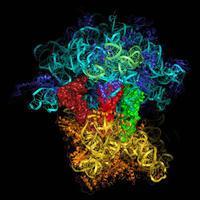The ribosome, a molecular machine powered by RNA, is responsible for protein synthesis. Ribosomal RNA processing mature and its association with ribosomal protein is the basic process of ribosomal subunit assembly. In eukaryotic cells, this process is conducted in the nucleolus. As a nucleolar complex for small-subunit ribosomal RNA processing, small-subunit (SSU) processome has been extensively studied mainly in Saccharomyces cerevisiae, but not in diverse organisms, leaving open the questions of whether it is a ubiquitous mechanism across eukaryotes and how it evolved in the course of the evolution of eukaryotes.
The research team “Evolutionary Genomics of Eukaryotic Cells” led by Prof. Wen Jian-fan of Kunming Institute of Zoology, CAS has embarked on the investigation of the origin and evolution of the RNA processing machinery.
Genome-wide survey and identification of SSU processome components were carried out from 77 representative eukaryotes of all five super groups as well as numerous prokaryotes (including 1375 eubacteria and 67 archaea), and phylogenetic analysis was then performed on each of them. The investigation shows some interesting results: 1) The majority of the yeast SSU processome proteins possess homologs in almost all of the main eukaryotic lineages, suggested that SSU processome has been the universal SSU RNA processing machinery in eukaryotes. 2) A fairly complete form of the complex emerged in the last eukaryotic common ancestor (LECA), began with abundant protein homologues being present in archaea but few in eubacteria. 3) Phylogenetic analysis indicated that ancient gene duplication and functional divergence occurred frequently during the evolutionary origin of the LECA from prokaryotes. Gene duplications not only increased the complex’s components, but also extended its nucleolar, even some non-nucleolar (but nuclear) functions, implying the evolutionary emergence of the sub-nuclear compartment -- the nucleolus. 4) And gene duplication, innovation, and loss, caused further divergence of the complex during the divergence of eukaryotes.
Thus, this study prompts LECA as a complex eukaryotic cell, harbored not only complicated SSU processomes but even a nucleolus, and furthered our understanding for the origin and evolution of eukaryotic cell on the basis of its prokaryotic counterpart. The result has been officially published on Genome Biology and Evolution recently.
This research project has been supported by grants from the NSFC, the Knowledge Innovation Program and 973 Program.
The main findings of this research can be found:
http://gbe.oxfordjournals.org/content/early/2013/11/07/gbe.evt173.full.pdf






